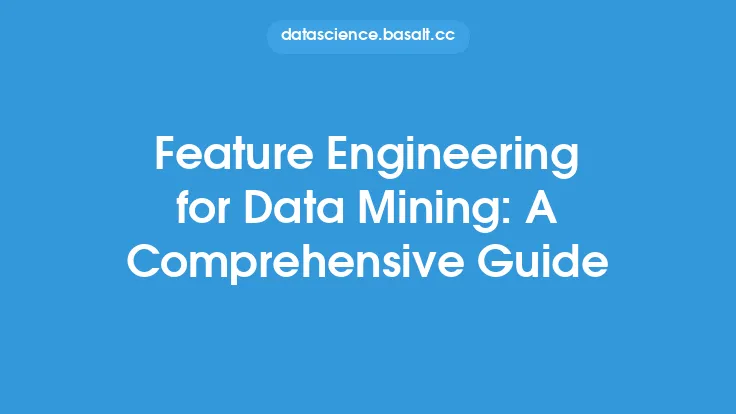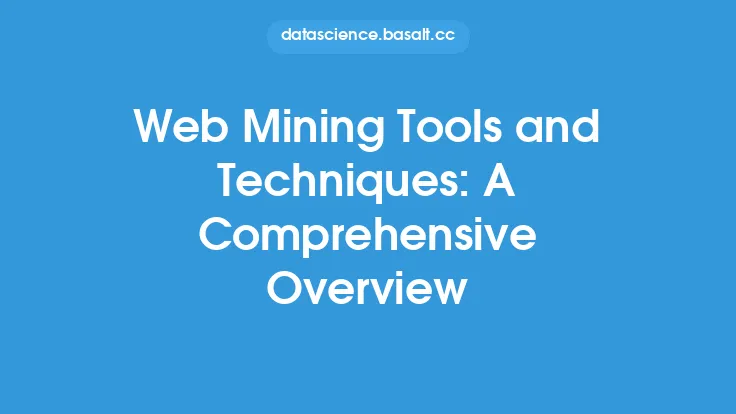Association rule mining is a crucial data mining technique used to discover interesting patterns, relationships, and associations within large datasets. It is a popular method for identifying correlations between different variables, which can help businesses, organizations, and individuals make informed decisions. In this article, we will delve into the world of association rule mining, exploring its concepts, techniques, and applications.
Introduction to Association Rule Mining
Association rule mining is a type of unsupervised learning technique that aims to identify patterns and relationships between different items or variables in a dataset. It was first introduced by Agrawal et al. in 1993 and has since become a widely used technique in data mining. The primary goal of association rule mining is to discover rules that describe the relationships between different items, such as "if a customer buys product A, they are likely to also buy product B."
Key Concepts in Association Rule Mining
There are several key concepts in association rule mining that are essential to understanding the technique. These include:
- Support: The support of an itemset is the proportion of transactions in the dataset that contain the itemset. For example, if a dataset contains 100 transactions, and 20 of them contain the itemset {A, B}, then the support of {A, B} is 20%.
- Confidence: The confidence of a rule is the proportion of transactions that contain the consequent (the item on the right-hand side of the rule) given that they also contain the antecedent (the item on the left-hand side of the rule). For example, if a rule is "A → B," and 80% of transactions that contain A also contain B, then the confidence of the rule is 80%.
- Lift: The lift of a rule is the ratio of the confidence of the rule to the support of the consequent. It measures the strength of the association between the antecedent and the consequent.
- Itemset: An itemset is a set of items that appear together in a transaction. For example, {A, B, C} is an itemset.
Techniques for Association Rule Mining
There are several techniques used for association rule mining, including:
- Apriori algorithm: The Apriori algorithm is a popular technique for association rule mining. It works by generating all possible itemsets and then pruning them based on their support and confidence.
- Eclat algorithm: The Eclat algorithm is another technique used for association rule mining. It works by generating all possible itemsets and then using a vertical database layout to efficiently count the support of each itemset.
- FP-growth algorithm: The FP-growth algorithm is a technique used for association rule mining that works by creating a compact data structure called an FP-tree. The FP-tree is then used to generate all possible itemsets and their supports.
Applications of Association Rule Mining
Association rule mining has a wide range of applications in various fields, including:
- Market basket analysis: Association rule mining is widely used in market basket analysis to identify patterns and relationships between different products. For example, a retailer may use association rule mining to identify which products are frequently purchased together.
- Recommendation systems: Association rule mining is used in recommendation systems to suggest products or services to customers based on their past purchases or behavior.
- Medical diagnosis: Association rule mining is used in medical diagnosis to identify patterns and relationships between different symptoms and diseases.
- Financial analysis: Association rule mining is used in financial analysis to identify patterns and relationships between different financial variables, such as stock prices and trading volumes.
Challenges and Limitations of Association Rule Mining
While association rule mining is a powerful technique for discovering patterns and relationships in data, it also has several challenges and limitations. These include:
- Scalability: Association rule mining can be computationally expensive and may not be scalable to large datasets.
- Noise and missing values: Association rule mining can be sensitive to noise and missing values in the data, which can affect the accuracy of the results.
- Interpretation of results: The results of association rule mining can be difficult to interpret, especially for non-technical users.
- Overfitting: Association rule mining can suffer from overfitting, especially when the number of items is large.
Real-World Examples of Association Rule Mining
Association rule mining has been successfully applied in various real-world scenarios, including:
- Retail industry: Walmart, a leading retail chain, uses association rule mining to analyze customer purchasing behavior and identify patterns and relationships between different products.
- Healthcare industry: The University of California, San Francisco, used association rule mining to analyze electronic health records and identify patterns and relationships between different symptoms and diseases.
- Financial industry: JPMorgan Chase, a leading financial institution, uses association rule mining to analyze financial transactions and identify patterns and relationships between different financial variables.
Best Practices for Association Rule Mining
To get the most out of association rule mining, it is essential to follow best practices, including:
- Data preparation: Data preparation is critical in association rule mining. The data should be cleaned, transformed, and formatted to ensure that it is suitable for analysis.
- Parameter tuning: The parameters of the association rule mining algorithm, such as support and confidence, should be carefully tuned to ensure that the results are accurate and meaningful.
- Result interpretation: The results of association rule mining should be carefully interpreted, taking into account the context and domain knowledge.
- Model evaluation: The performance of the association rule mining model should be evaluated using metrics such as precision, recall, and F1 score.
Future Directions of Association Rule Mining
Association rule mining is a rapidly evolving field, and there are several future directions that researchers and practitioners are exploring. These include:
- Integration with other techniques: Association rule mining is being integrated with other data mining techniques, such as clustering and classification, to create more powerful and robust models.
- Handling big data: Association rule mining is being adapted to handle big data, including large volumes of structured and unstructured data.
- Real-time analysis: Association rule mining is being used for real-time analysis, enabling organizations to respond quickly to changing patterns and trends.
- Explainability and transparency: There is a growing need for explainability and transparency in association rule mining, enabling users to understand the underlying patterns and relationships in the data.





